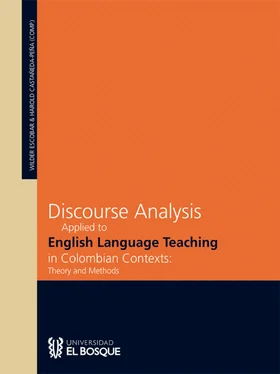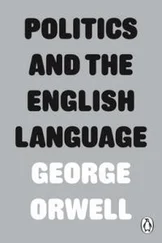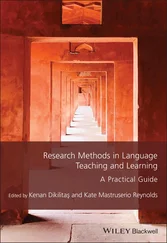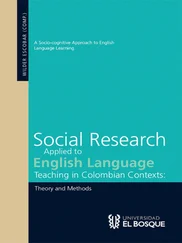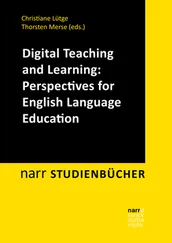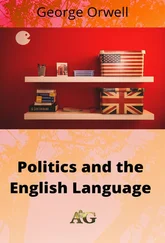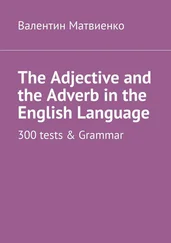Analyzing discourse beyond the fundamentals of language while bearing in mind the reciprocal influencing-dynamics that culture and language exert on one another (Escobar & Gómez, 2010) can shed light on the ways in which society structures and engages in communication as well as how such communication builds and transforms society, generates common sociocultural representations, and establishes a social order to reveal collective principles: the ideologies, values, and idiosyncrasies associated with language behavior (e.g. patterns of language use, language variations, and language evolution).
Similarly, discourse operates alongside cognitive domains creating, establishing, and justifying a socially constituted body of knowledge. In their exploration of this, Appel and Lantolf (1994) sought to explore ways in which speaking mediates thinking, comprehending, and higher-order cognitive processes to claim that “speaking not only mediates the subjects’ attempts to report on what they understand from a text, but also how it serves as the process through which they come to comprehend a text” (p. 437). That is to say, “discourse is a particular way of talking about and understanding the world (or an aspect of the world)” (Jørgensen & Phillips, 2002, p. 1). However, discourse does not just enable knowledge construction and its diffusion, it also serves as a screening mechanism which selects what knowledge claims can be socially acknowledged by positioning people in places, employing means of communication, and designing discursive strategies that regulate what can be said about something, Foucault’s “when, where, and how” (1988). Consequently, discourse analysis may prove useful in both informing cognitive processes and uncovering the discursive strategies that establish knowledge both in society and in intentions.
At a personal level, discourse embodies ways of constructing and reconstructing our views of the world and our relationships to others, means of devising strategies to position and reposition ourselves so as to take up distinct roles in society, forms of acting in, and interacting with the world, of representing and interpreting realities and of thinking, doing, and being and thus, ways of manufacturing the self in light of the multifaceted power dynamics of social interaction (Clark, 2010; Fairclough, 2003; Foucault, 1988; Gee 1996, 1999; Norton, 2000). Examining this would help us understand the formation processes of social constructs like membership, positioning, gender, community, otherness and their corresponding associations with past experiences, present developments, and future possibilities.
At a political level, the rise of spoken discourse prompted individuals to imagine themselves as part of communities, and gave birth to the concept of nationalism which was successively reinforced with printed discourse that stressed common characteristics (capitalism, Christianity, democracy, etc.,) and downplayed the differences between sub-groups (Anderson, 2006). In this regard, social forces at work have taken various forms: from the use of the most powerful biological weapons to subtle pursuits for communication control. On the one hand, country incursions like the bombing of Hiroshima and Nagasaki or the attack on Pearl Harbor in Hawaii were displays of force in the quest for power accompanied by discursive elaborations of national identities, supremacy, sovereignty, and justice. Subtle occupation campaigns, on the other hand, involve the monopolization of the media: propaganda, news, movies, satellites, radio and television stations, and other forms in addition to discourse channels which exemplify the creation of confusion, bewilderment, and perplexity: “Modern and more effective power is mostly cognitive, and enacted by persuasion, dissimulation, or manipulation, among other strategic ways to change the minds of others in one’s own interests” (Van Dijk, 1993, p. 254). Hence, the value of being able to discern such phenomena lies in the potential to identify outdated and unjust social structures, to raise awareness, and to strive for social change.
Examining the nature of language and its relationships to the self, others, thought, knowledge, culture, and society is every bit what education should be about. Rogers et al. (2005), for example, explores literature about discourse analysis in education in light of those relationships it establishes with the physical and social domains (e.g. explaining methods, studying issues of reflexivity, and discussing singularities like ideology, privilege, power, and control) to conclude that critical approaches to discourse analysis have changed education and this, in turn, has widened the boundaries and altered the characteristics of discourse analysis itself.
In this specific area of English education in the Colombian national context, researchers have increasingly embraced discourse analysis to fulfill a wide range of functions. To better understand how language works, for example, Chapetón (2009) employed a qualitative and quantitative mixed-approach to discourse analysis to study frequency, distribution, and functions of discourse markers in EFL student interaction to describe pragmatic characteristics of such discourses. Castañeda (2012), on the other hand, utilized its tools to characterize discourses which emerged from women EFL learners in online discussions about literature and how language mediates their social exchanges and, consequently, their learning processes. Maloof and Housset Fonseca (2009) taught critical discourse analysis to enhance the critical thinking processes of students. On the topic of identity, Soler (2012) explored ways in which ethnic identities are discursively constituted around dynamics of adaptation, resistance and negotiation in learning. Gómez (2012) studied processes of identity construction in the EFL classroom and their relation to the development of the target language.
Moving beyond the impact that discourse analysis may have in the micro-level contexts of individual EFL classrooms, in the policy realm, Guerrero (2010) analyzed official discourses to describe the ways in which English teachers are portrayed in documents like the Estándares básicos de competencias en lenguas extranjeras: inglés. Formar en lenguas extranjeras, el reto [Basic Standards of Competencies in Foreign Languages: English. Development in Foreign Languages, the challenge]. Escobar (2013), on the other hand, frames a study of English policymaking processes in Colombia under discourse analysis principles to illustrate discursive strategies employed to form and transform identities and, thereby, justify asymmetrical power structures in English education.
Despite the numerous aforesaid examples of studies on discourse analysis, the discussion addressing the corresponding relations of second or foreign language acquisition and discourse analysis in the Colombian context is still limited (Castañeda-Peña, 2012); hence, this book, Discourse Analysis Applied to English Language Teaching in Colombian Contexts: Theory and Methods represents an attempt to complement such discussions by depicting social practices in EFL teaching and learning processes and contributing to the academic community with the assertions that may ensue in regard to language knowledge, social constructions, and dynamics of power and control.
This book presents a conceptualization and contextualization of discourse analysis, followed by studies of language patterns, structures of conversations, identity constitution, and the vision of virtual communities through online interactions. It concludes by drawing assertions between discourse analysis and the acquisition of English as a foreign language in Colombian contexts.
The first chapter, ‘Classroom Discourse Analysis: Outlining the Field’ draws constituents from many different discourse analysis approaches to situate and characterize classroom language. To begin, it deliberates on how discourse studies define classroom language. Subsequently, it delineates discourse analysis in general educational settings, from feminist post-structural analysis (a derivation) which facilitates the understanding of power dynamics of learning in foreign language classroom interactions. Accordingly, the author elaborates and advises on methodological implications regarding classroom discourse to finally expand on the analysis of discourse for English as foreign and second language settings.
Читать дальше
